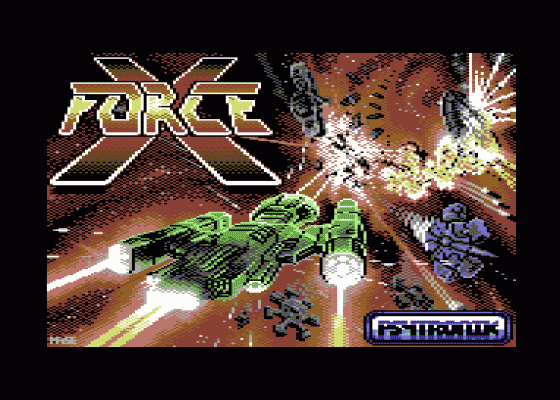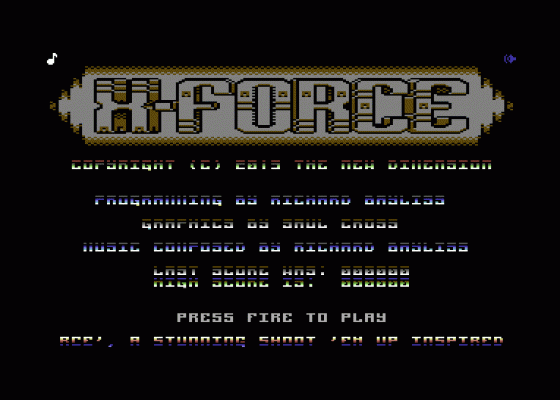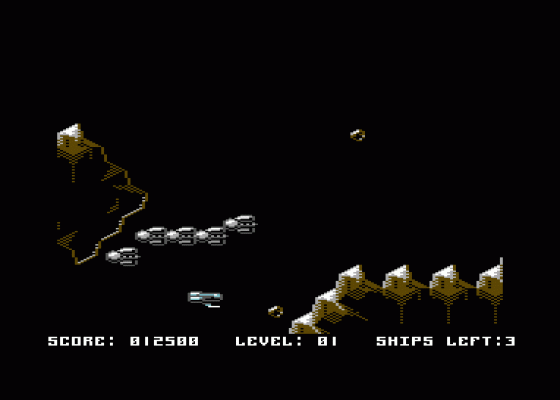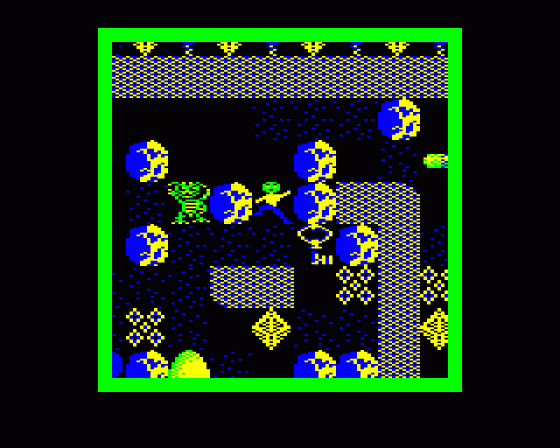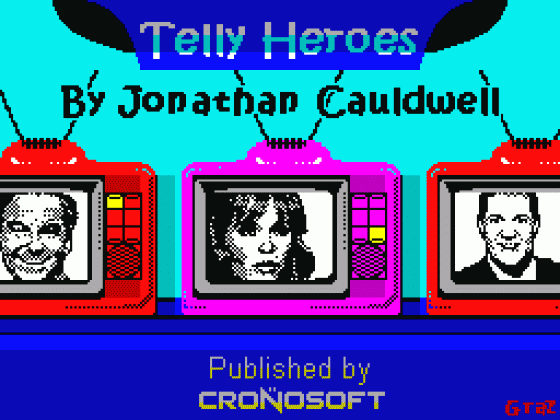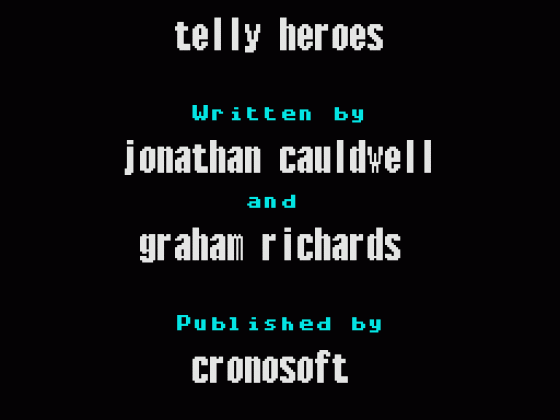
Micro Mart
 6th August 2015
6th August 2015
The Commodore 64 gets another shooter, Repton returns to the Acorn Electron and Cronosoft releases two more Spectrum classics... It's another Retro Round Up by Dave Edwards
Introduction
Welcome to the Retro Round Up, where we take a quick goosey-gander at new games for the machines of yesteryear. This month we're jumping straight to the reviews. You'll find a new section at the end named Soapbox; an occasional "aside" that offers my take on particular 'developments' in the retro world outside of the thriving software scene.
May The Force Be With You
First off the pile is X-Force, which is the big new release from Psytronik (www.psytronik.net), a nifty sideways-scrolling shooter with one of the highest difficulty levels ever. It's for the Commodore 64/128 and comes with the usual Codemasters-inspired inlay.
The game itself doesn't deviate from the regular format we're all used to and gives you a craft that can fire small bullets directly forwards. Formations of alien ships thunder into the smoothly-scrolling playing arena. They come from above, below, in front of you and behind you and at supersonic speed. At the same time, an intricately designed series of obstacles occasionally force you to choose to fly along the top, the bottom or in the middle of the screen.
That puny weapon can be upgraded by flying into blobs that appear. Catching them isn't easy as they float "in front of" the very obstacles you need to avoid. With practice though you'll see your ship upgraded with fireballs/lasers that cover a larger target area.
X-Force is very full-on; its stress levels left me wanting to seek medical advice.
It never ceases to amaze me when developers make games this difficult. In X-Force's case, you need to remember exactly which alien ships appear at which points of the level. There's little time to react to anything on your first attempt and attack formations are not those of more lenient shooters - your enemies do not glide around the screen in graceful arcs. No, they dart about in patterns that are impossible to predict. The invariable result is therefore a collision, and a glut of "game over" messages.
Rather tellingly, all the screenshots you'll find promoting X-Force are from the early stages of level one. That's for good reason - you would need tremendous fortitude to get any further, and I suspect most people will just give up trying after a few goes.
This is quite tragic. X-Force is a well-produced, bonus-filled, reactive, graphical extravaganza on which a team labored for years. In fact, slow it down 50% and it's hard to find anything to moan about. But on a real Commodore 64, when you don't have such an option, it'll have you hurling your joystick out of the window in five minutes maximum.
Repton Returns To The Electron
Repton is something of a retro-game icon; the thinking British man's equivalent of the American's boulder-dashing Rockford. In the Eighties he averaged one new adventure per year. Like all the greats however, he then took a hiatus only to be rebooted for die-hard fans twice as mean and twice as difficult for Repton: The Lost Realms. This game takes the best bits of the franchise and shakes it up with some new inclusions too.
The basic premise of the Repton games is to guide your lizard through an overhead maze, collecting up all the diamonds. Some diamonds are easily acquired; others are either in safes or placed alongside precariously-balanced rocks. Yet more may be supporting an egg, meaning they cannot be collected without releasing a monster. Even more may be placed in the corner of the maze next to a growing fungus, meaning you need to high-tail it over there before the fungus cuts off access to them entirely.
The history of Lost Realms is as fascinating as the game itself. Originally Repton 4, it builds upon those familiar elements above with a raft of others. Notable additions are balloons (reverse rocks that float upwards), an ice pill to freeze any monsters released from their eggs and a pill-door combination in addition to the key-safe one. The wall-hugging spirits from Repton 2 are also turned into two different "types" of nasty too.
Repton 4, with all of these new inclusions, was not however considered viable. A half-finished version of it was shelved for twenty years before it found its way to Retro Software. Almost another decade later, the Acorn Electron version of Repton: The Lost Realms has finally appeared. The BBC Micro version of the same game was released five years ago.
And so has it been worth the wait? Well, that all depends on what angle you approach it from. If you're a hardcore fan, snuggle up to a cuddly Repton at night and can complete levels blindfolded then probably yes. If you're new to Repton in its entirety, probably no. Lost Realms is very tough and it will likely make you very dispirited very quickly.
There is no getting away from the fact that this Acorn Electron version is inferior to the BBC one. The level maps are the same but sprite size is smaller and less well-detailed, game speed slower (plodding rather than fluid) and music non-existent. To be fair, this has always been the case with the Repton Electron versions. The BBC includes a hardware scroll chip which the Electron doesn't have. Implementing software-scrolling takes up valuable memory and that memory has to come from somewhere, leaving less memory for sprites. Changes that significant then require almost an entire rewrite.
Mind you, you do have to give the boys at Retro Software marks for perseverance. They've disassembled the original code, attempted to finish it, abandoned that idea, written their own code based around the original code as prototype, designed their own level sets and editor tools. One might have thought, after all that and the release of the BBC version, that they would have called time on the project and had a well-deserved rest. But no, they have instead repeated the whole process over to produce an Electron version, simply to cater for those ten people who might want to play it on an Electron instead!
Bravo. After such an epic struggle, I now come along and bash it for being too slow, too complex and too difficult. Shame on me. Alas, it is all of these things and, whilst the packaging and inlay is superb, the additional elements of the game take the idea that one step too far. Sometimes, less really is more.
To finish on a positive note though, the BBC version is a much brighter and speedier number. As the two versions cost exactly the same, plump for the BBC and you'll be playing the lost realms of Repton as I suspect Retro Software originally intended. Both versions cost £4.95/£6.95 on tape/disc.
All The Fun Of The Fair
A new game for the Spectrum 16K, and a fully-featured imagining of Theme Park?! Surely not, but, yes, Cronosoft's Jonathan Cauldwell has done it again. He's created another unique game which mixes arcade elements with strategy and decision-making. As if it needed saying, you're in charge of a large plot of land and your mission is to construct the next record-breaking "family day out" attraction - and not go bankrupt in the process.
If you've glanced at the screenshots by now, I know what you're thinking. Fun Park has the appearance of a game from 1981, an era where the 8x8 CHR$ definition was king. You're right and that, unfortunately, will put many people off. So pay attention when I comment that, had the game been released in that era, it would have been so ahead of its time that it may well now be remembered with the same fondness as Football Manager.
Fun Park requires instructions as to its use - there are none on-screen and no prompts for which keys to press. However, the navigation keys are easy enough to use and once you realise key 1 lays a path, you've taken your first steps to building that entertainment utopia.
No-one will visit your park until you build at least one ride, and you build all rides (of which three are available at game start) by bringing up a blue selection screen, paging through those available and selecting with key M. Oddly, ENTER is used to abandon the ride-hunt rather than to confirm.
Once you have a ride, you need to construct a special type of path (key 2) to its entrance and exit. These paths only work if you connect them vertically, which is easily enough done but which leads you to discover the game's biggest drawback if you get it wrong.
This drawback is that it is not possible to erase any mistake you make or the position of any ride you place. Ugh. The instructions explain that, working with only 16K, there just wasn't any space left to include this feature. That's perfectly valid but it has obvious ramifications.
Your limited finances restrict you initially to a few trees, a few rides and paths between them. Fortunately you can increase ticket prices to generate more income and once you've worked out that you must not set these too high but in proportion to how "good" your park is, you'll start to understand the mechanics of Fun Park a little more.
And this is really the whole point. Running a successful park isn't easy - money is tight and there are always new rides to research, new customers to attract, new security to invest in and new paths to lay to connect everything together. If your park is struggling, you can also take out a loan (on which you'll pay interest) and try and dig yourself out of the red. Despite the loan facility, the game is rather harsh in declaring "You're bankrupt!" should you end the month without enough cash to pay everyone's salaries. The skill is therefore working out how to run the park profitably.
Fun Park is available for £1.99 as an emulator file only from cronosoft.co.uk.
Telly Heroes - Retro Find Of The Month
Telly Heroes is another Cronosoft game and, from its packaging, I thought it would be a quiz game. It's not. It's a strategy game in which you take over a completely fictional British Broadcasting Corporation and then decide what programmes to broadcast. The aim is to make a mint, flogging off DVDs of your favourite shows, selling advertising on your channel and providing a whole range of services like interactive TV and teletext.
This type of game won't appeal to everyone but, even if it's not your thing, you can't help but marvel at the sheer amount of features it includes and the finesse with which it has been put together. The majority of it, it has to be faced, is text-based. So that means reading menus, reports, TV schedules and other information from the get-go. Fortunately it's made exciting by telephone complaints (usually about bad language pre-watershed), media breaks and graphics of all those aspiring celebrities desperate for your employment.
Telly Heroes is peculiarly British and that's really great - if you are British. When commissioning your new series - which can be called whatever you like and be of whatever genre you wish - a whole swathe of famous faces are at your beck and call. All are not-so-subtly altered so you won't find Amanda Holden waiting to take the lead in your new show - but Amanda Holdem will be pleased to do it in her stead.
If you're not a stalwart British TV fan however, there's less for you as you simply won't intuitively understand the game in the same way. The reason I say this is that a lot of the game's "humour" isn't laugh-out-loud funny; it comes from your own intuitive "pairing off" of genres and celebrities that don't match. Why not commission a new series of University Challenge hosted by Jade Giddy, for example?! If you're British, the idea will raise a smile. Furthermore, if the show goes on to succeed, and gains immense viewing audiences and a steady trade of DVD sales, you will take from this whatever you brought to it when deciding to do it in the first place. But if you're not British, all of this is lost; it becomes a simple pot-luck choice without meaning anything at all.
I have no idea of what logic Telly Heroes employs to determine success and, strangely enough, I don't really care. Probably the worst thing you could do with Telly Heroes is actually take it seriously. It's a fantastic, albeit totally ridiculous, concept which is as fascinating a departure as you can imagine from the norm of retro game releases. A perfect way of wasting time from Cronosoft for £3.99 + P&P.
Soapbox - When Retro Goes Bad...
The Internet was built to be open and the world of retro gaming truly represents a medium that the Internet was made for. It allows collectors to find things, programmers to make things, gamers to play things and archivists to preserve things. Almost every computer ever created has claimed its own corner of cyberspace. And the bigger the machine was, the more complete the on-line archives for it are.
One of these retro machines, the Amstrad, was a phenomenon across Western Europe and the website CPC Power has over 12,000 (!) cover scans, screenshots and inlay cards to browse. But four weeks ago came a change - its webmaster announced that "due to the constant plundering of its resources without due recognition, it would henceforth be watermarking all of its images". The result: A huge diagonal "CPC Power" stamped across every last scan. It's one of the biggest mistakes I have seen an archive site make and, before we get to this month's new releases, I'll explain exactly why.
Firstly, if you obscure an image, you disconnect the viewer. We don't stamp "Micro Mart" diagonally across the pictures that illustrate our reviews for that reason. No-one wants to see things that way. It ruins ambiance.
Secondly, if you are laying claim to your "version" of a retro game, where does that claim end? You've effectively created a new inlay for it with your logo on. Why not protect it by also doctoring loading screens and/or credits pages too? Indeed, maybe you should make your downloads only work with an "official" emulator embedded into your site?
Thirdly, the Internet is about sharing information, be that images or whatever, with the world. To do the equivalent of taking a poop on those images - because you're worried about people stealing them because they are so good! - is "solving the problem" by actually destroying the very image you created! That flies in the face of providing the images in the first place.
To get an idea of where CPC Power is coming from, you need to see it from its perspective. Most retro gaming websites have smallish images and instructions converted to html. But CPC Power hosts big, high-res images. The open nature of the web will mean that all those people clicking Save Image As are costing it in terms of bandwidth. As someone who runs an archive site, I know it is also gut-wrenching to see your years of hard work ripped off on other sites.
Yet, as someone who collects Amstrad games - and indeed one of those "plunderers" of many an archive site over the years - I do think CPC Power is overstating its case. The fact is that if you're about to sell an Amstrad game on Preloved or eBay, it's much easier to do a google image search than faff around with your camera. Intrusively watermarked images will indeed stop you saving them, but more likely you'll then either do the faffing or find the image elsewhere. If the latter, it will be unwatermarked and in good supply if CPC Power's images have been plundered to even half the extent it is claiming.
So essentially, what watermarking actually does is drive visitors away. There is even a precedent. Remember the watermarked images of cover scans on DragonWiki? No? Precisely. Because everyone preferred the unwatermarked ones on The Dragon Archive, which quickly became Dragon fans' destination of choice for precisely that reason. I don't hold out much hope of CPC Power reversing its policy any time soon either. Which is a great shame.
Au Revoir
That's all for this issue. Perhaps by next month I'll have built my perfect Fun Park. Well, all apart from that one tree that I can't erase, of course...
Scores
(Spectrum 16K/48K)
(Acorn Electron)
(Spectrum 48K/128K)
(Commodore 64/128)

